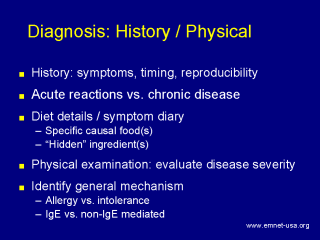 |
As is the case for
all medical illnesses, diagnosis rests upon a careful history and physical
examination. The history, as it pertains to food-induced allergic reactions,
must focus upon the symptoms elicited, the timing of the symptoms in
relation to food ingestion, and reproducibility of reactions. Acute
reactions to isolated ingestions should be differentiated from chronic
disease related to food. Dietary details are key and a symptom diary may be
helpful. The physical examination focuses on the exclusion of non-allergic
causes of food-induced symptoms. The physician should be able to conclude
the history and physical examination with an idea of whether an allergy or
food intolerance is on the differential diagnosis and whether IgE or non-IgE
mediated mechanisms are playing a role. |
